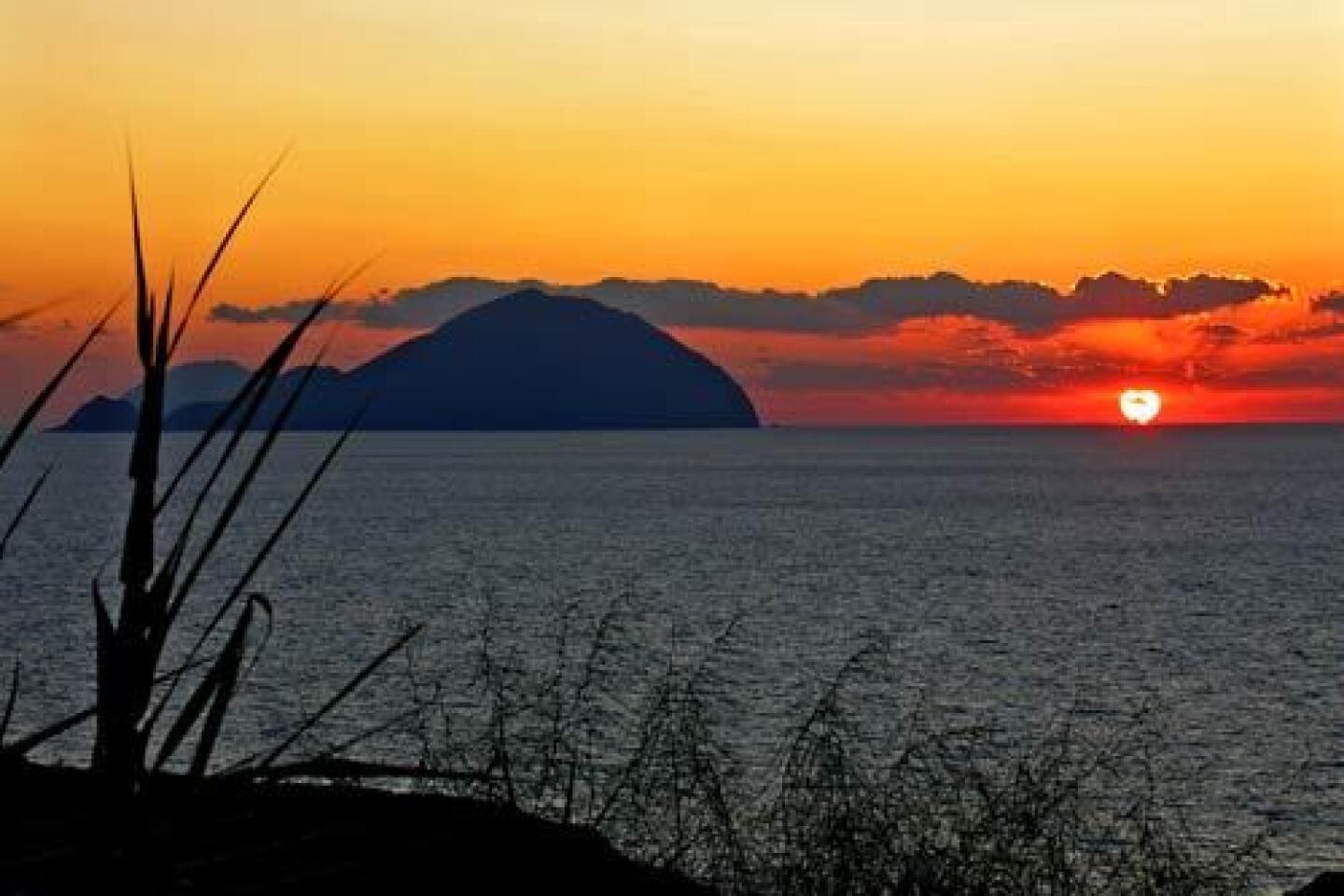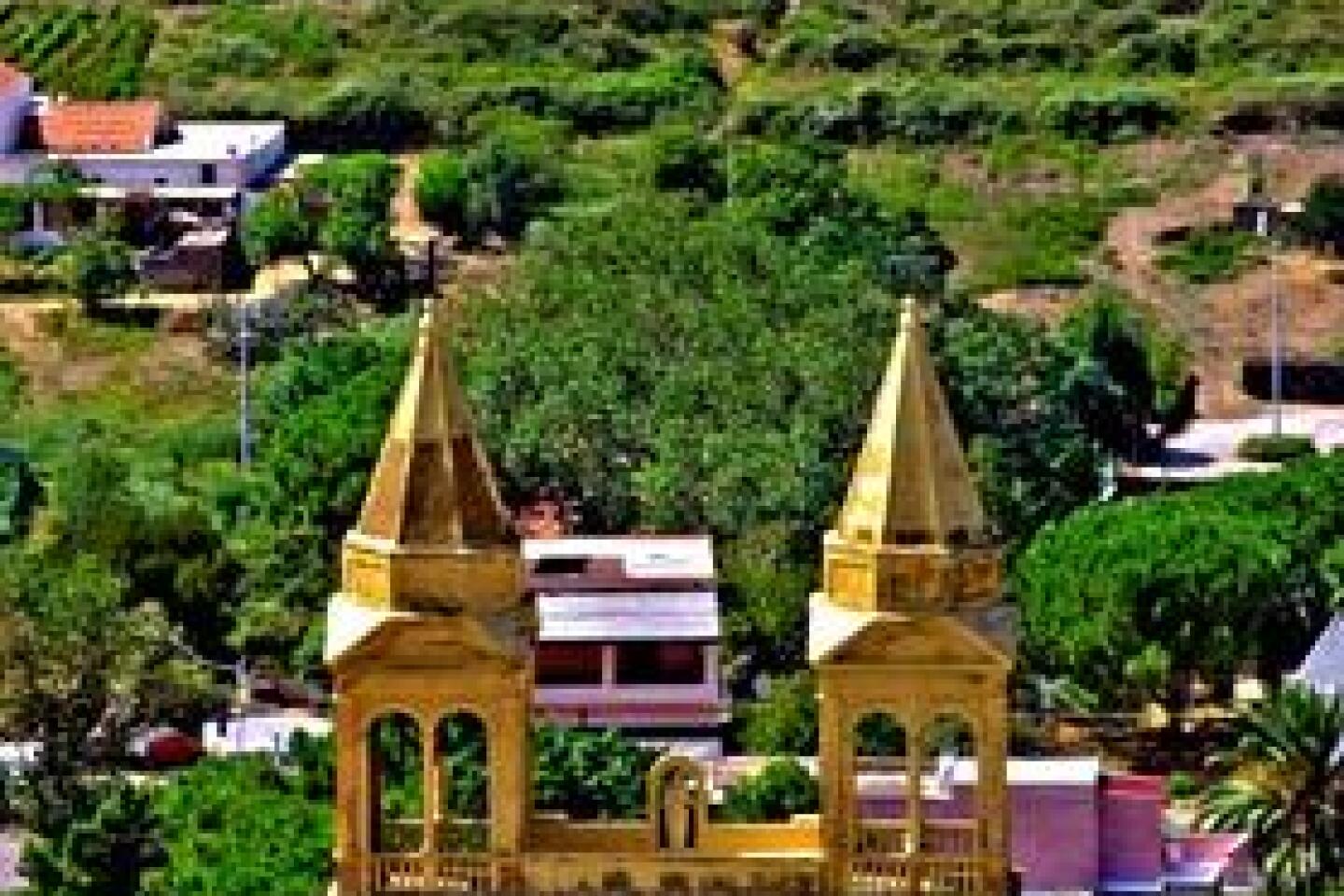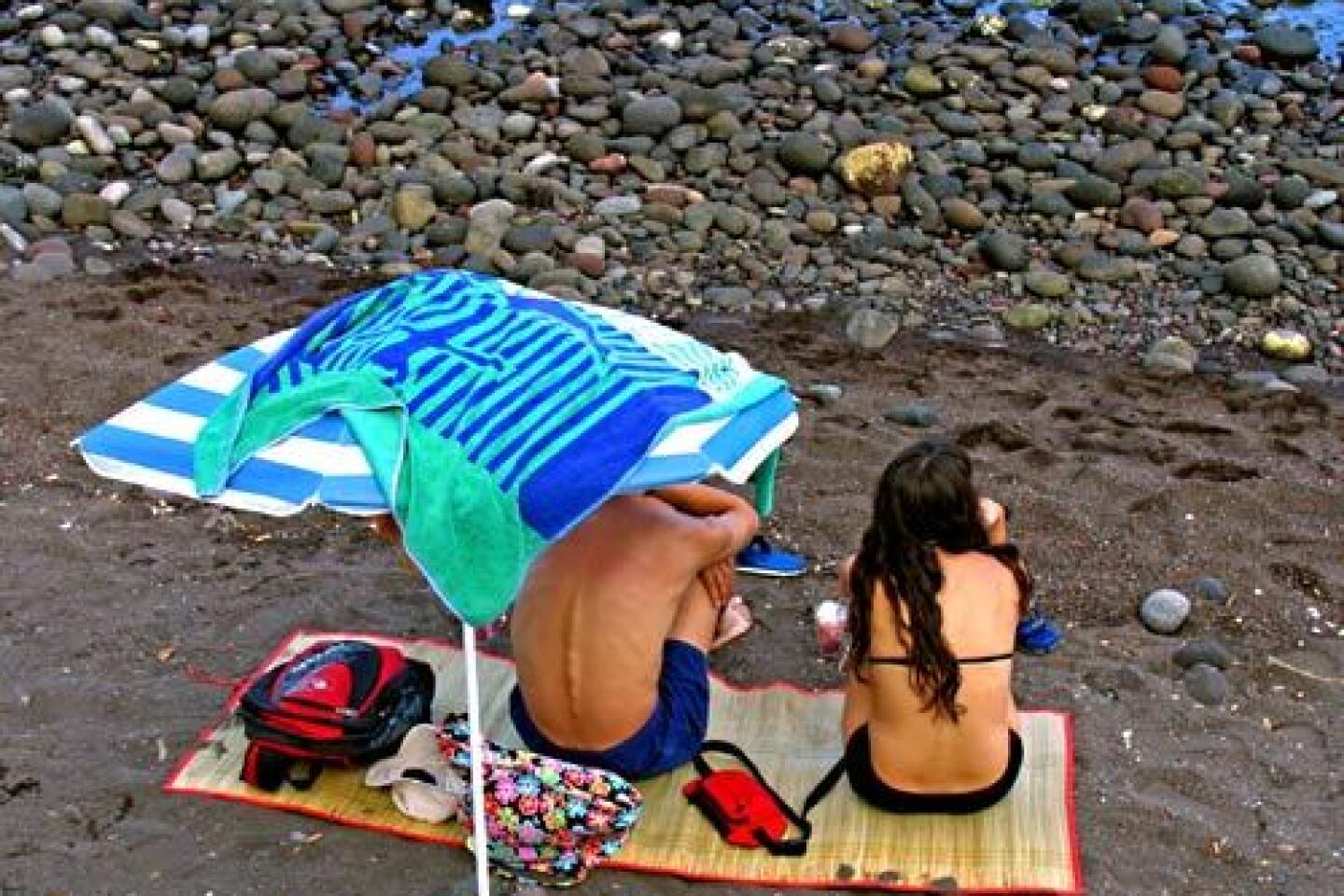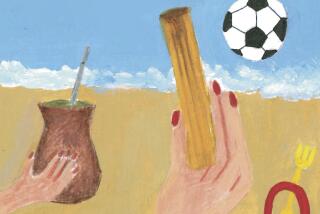North of Sicily, Salina erupts with calm beauty
I can stop looking now. I’ve found my dream island.
It’s Salina, one of seven small Aeolian Islands (also known as the Lipari Islands) cast up by volcanoes in the Tyrrhenian Sea about 50 miles north of Sicily. They’re accessible only by helicopter or boat, so that keeps crowds at bay. All of them are enchanting, including the main island of Lipari, where my Italian grandfather was born.
FOR THE RECORD:
Salina, Italy: A Travel article Sunday about the Aeolian Islands, including Salina, reported that many residents immigrated to the U.S. around the turn of the 19th century. It was the turn of the 20th century. —
But Salina is divine, partly because it is just the right size, with a population of about 3,000 on 10 square miles, wrapped around two almost identical volcanic cones: 2,818-foot Monte dei Porri and 3,156-foot Fossa Delle Felci, the highest peak in the archipelago.
Volcanologists say the twins last erupted 13,000 years ago. Colonists came from the mainland, followed by Greeks and Romans, though the island remained sleepy and remote and thus out of the mainstream. A grape blight in the late 19th century spurred mass emigration, and in 1953, Salina’s salt mines closed. After that nothing much happened, apart from the arrival of tourists and filmmakers, including Michael Radford, who used the island as a set for the 1994 movie “Il Postino.”
Unlike Sicily, Salina has no great archaeological sites or artistic treasures to see. Indeed, Salina’s only attraction is its own sweet self. It has a pair of ports, Rinella and Santa Marina Salina; a few sun-struck villages set among olive groves and caper farms; about 30 miles of cracked single-lane roads bordered by bright yellow broom; swimming coves with translucent water; some of the best food in the Mediterranean; and glorious views in every direction.
The Sicilian coast hangs low on the southern horizon. Lipari is across a narrow channel to the east, with barren Vulcano peeking out from behind. Beyond diminutive Panarea to the northeast, lava flickers on the flanks of fuming Stromboli, and from the village of Pollara you can watch the sun set over tiny Filicudi and Alicudi, which trail like ellipses into the west.
In September I came here by hydrofoil, a three-hour trip from Palermo to Santa Marina Salina, where people in wet bathing suits were lapping gelato on the waterfront piazza. The taxi to my hotel rounded the northeast side of the island, passing the Capofaro lighthouse and vineyards heavy with almost ready-to-harvest Malvasia grapes that give their name to the island’s well-known dessert wine. The road corkscrewed, then straightened out as it approached the town of Malfa.
Set on a sloping plateau above the island’s rocky north coast, Malfa is a jumble of classic, cube-shaped Aeolian houses in tutti-frutti colors. Porches lined with jugs of homemade wine are festooned with strings of tomatoes drying in the sun next to beach towels. Bushy caper plants stake claim to every vacant lot, bearing the precious little green buds that give a kick to island fish and pasta.
Malfa’s main street has a church and piazza where the vegetable truck stops and a few booths that sell boat excursions to neighboring islands, including nocturnal visits to Stromboli. In the height of summer the town holds concerts and film series. Apart from that, there’s nothing much to do besides sitting at a table shaded by an umbrella nursing a granita de café. This island specialty lives in the same family as iced coffee but is way more delectable than anything by the same name served at Starbucks.
Side streets start out wide enough for cars and motor scooters, then narrow to admit only pedestrians, most of them headed for the swimming cove at Punta Scario or to one of the hotels on the cliff above.
The perfect island has to have a perfect place to stay, and the Hotel Signum is about as close as it gets, in my book. It has 30 endearing rooms decorated with ceramics, potted plants and other island bric-a-brac, set around two shady patios and an infinity pool where you can gaze endlessly into the sea. The rooftop bar offers front-row seating for Stromboli’s nightly fireworks display, and the veranda restaurant is one of the best on the island.
I arrived in time for lunch, starting with a simple green salad followed by lasagna in a signature Aeolian sauce of tomatoes and capers. (Later I tried to re-create it in my kitchen at home, with disappointing results. Some tastes don‘t travel.)
Dinners were even better: fresh grilled swordfish, stuffed calamari, baby clam spaghetti, accompanied by Tenuta di Castellaro Bianco Pomice, a white wine from neighboring Lipari that tastes ever so slightly of peaches. Then pistachio semifreddo, a few sips of heady Malvasia and very sweet dreams.
Honestly, I don’t have a financial stake in the Hotel Signum. It is owned by Salina-born Michele Caruso, the chef, and his wife, Clara Rametta. They started it 25 years ago when there were no other hotels in Malfa, which is how locals wanted it. Since then the couple have added a stylish spa, and Clara has started collecting material for a Museum of Emigration in Malfa, which wasn’t open during my visit.
The island shared the woes of the impoverished Italian south, which sent waves of emigrants to the U.S. around the turn of the 19th century and to Australia in the 1950s. Most of them put down roots, but a surprising number of others, including Clara, who studied psychology in Boston, stayed only long enough to get an education and earn a bit of money before coming home.
It is easy to see what called her back to Salina, beginning with the cove about 200 feet below Malfa. It’s reached by a paved path that hugs the hillside on its way to the crenellated black pinnacle that marks Punta Scario. The beach is small, secluded and paved with wobbly boulders, worn smooth by the elements. At the cabana cafe tucked into the cliff, I had a shot of espresso, rented a rubber raft and launched it into the waves where I rocked like a baby in a cradle for the better part of the afternoon.
A little fleet of buses shuttles among the villages of Salina, but most people get around by motor scooter, so I rented one the next morning to explore the island’s east coast. Its top speed was about 40 mph, and the word “tourist” was emblazoned on the back plate. Good thing, because I’m a public nuisance on a scooter, constantly confusing the throttle with the brake.
Still, I loved putt-putting back around Capofaro to Santa Marina Salina, a great metropolis in island terms: It has ferry and hydrofoil ticket offices, cash machines and a post office. Its main street, Via Risorgimento, contains cafes, a bookstore and a few boutiques where women try on floppy sun hats and skimpy bikinis. In the piazza by the port is a twin-steepled, cantaloupe-colored church, paved with majolica tile donated by island lovers King Albert II and Queen Paola of Belgium.
Just beyond Santa Marina the road levels out as it approaches Lingua on the southeast hem of Monte Fossa Delle Felci’s skirt. The salt that gave Salina its name was mined from a stagnant lake near the waterfront, now an environmentally protected wetland where sandpipers and storks hang out.
Human migrants — especially those stopping by in yachts — are more attracted to Da Alfredo, a restaurant in the marina where people wait in line for pane cunzato, the house specialty, halfway between a sandwich and a pizza. Three women from the mainland let me join them at their table, where I wolfed down a pane cunzato topped with tuna, mozzarella and tomatoes. They advised me to order a delicious fresh melon and mulberry granita for dessert, then insisted on paying my bill. Happy people are generous people. So it goes on Salina.
The next day I took a bus across the saddle of land between Monte dei Porri and Fossa Delle Felci to the farming town of Leni, where I stopped at the d’Amico Azienda Agrobiologica to sample the farm’s red and white wines. Between sips I cleansed my palate with homemade caper paste spread on rounds of crusty bread, my idea of the perfect appetizer.
The next bus that passed took me down a long series of switchbacks, honking all the way, to the minuscule port town of Rinella, which has sea caves and a black sand beach.
After watching ferries dock and fishing boats come in, I bought a sandwich at a cafe, caught a bus back up the hill and got off at an avenue leading to the church of the Madonna del Terzito. It presides peacefully over the Valdichiesa valley, a pilgrimage site and retirement home for elderly islanders who refused to leave when their children emigrated.
A path behind the church climbs to the summit of Fossa Delle Felci, part of a nature preserve created in 1984 that keeps almost 4,000 acres of little Salina wild and free. Halfway up the mountain, I turned onto a secondary path leading back down to Malfa, according to my map, though a group of German hikers I met said I was going the wrong way.
They were right and wrong. The path was treacherously steep, in poor condition and hard to follow. But I stuck it out and finally came out of the underbrush on the edge of Malfa. I had scratches on my legs and twigs in my hair. But I returned for a soak in the pool, dinner on the terrace and one last lingering drop of Malvasia.
More to Read
Sign up for The Wild
We’ll help you find the best places to hike, bike and run, as well as the perfect silent spots for meditation and yoga.
You may occasionally receive promotional content from the Los Angeles Times.













